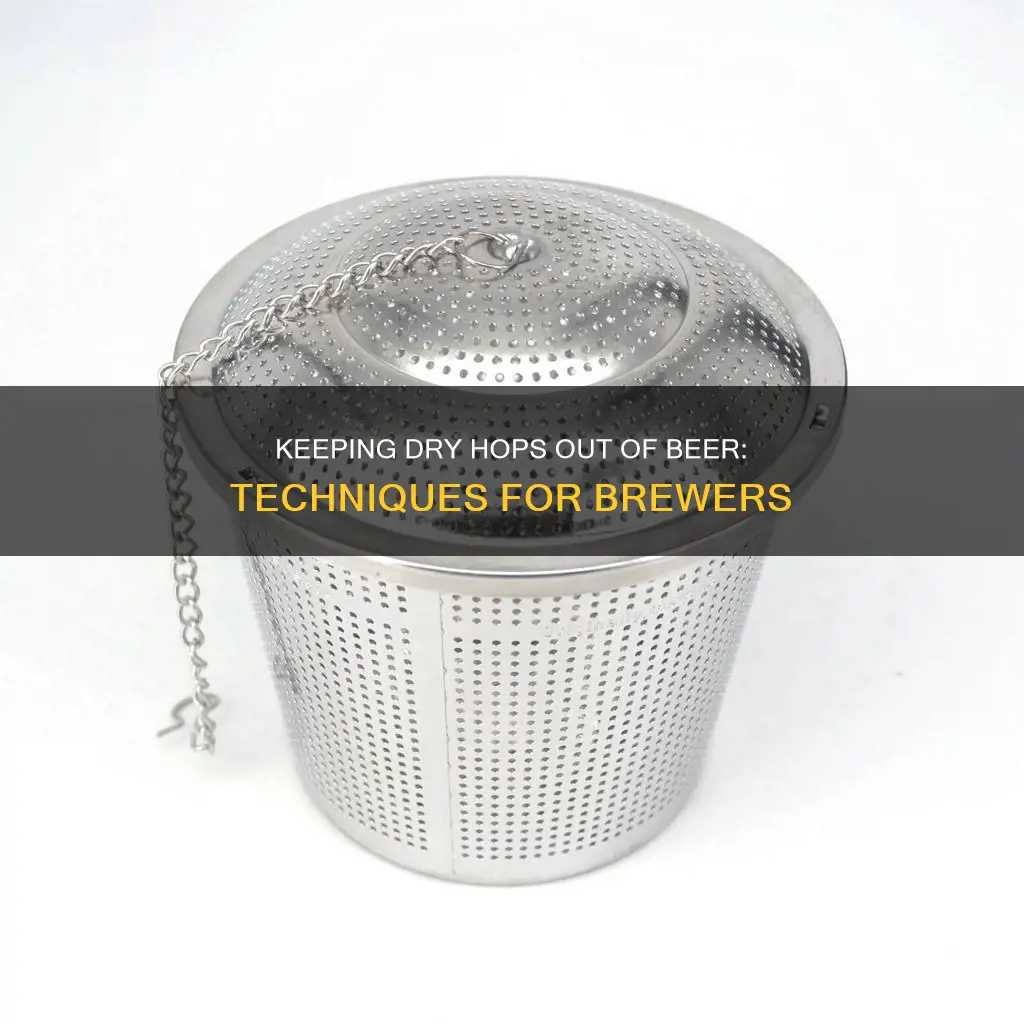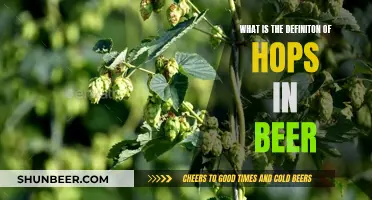
Dry hopping is the process of adding hops to beer after it has been cooled, usually during or after primary fermentation. This technique is used to add aroma and flavour to the beer without increasing bitterness. The hops used for dry hopping are typically low in alpha acid and high in essential oils. The amount of hops used depends on the desired level of aroma, with a general rule of thumb being one ounce of hops per five gallons of average-strength beer. The hops can be added directly to the beer or contained in a bag or strainer to reduce the amount of hops in the final product. While dry hopping can be done with either whole leaf or pellet hops, pellet hops are more convenient and readily available.
| Characteristics | Values |
|---|---|
| Purpose of dry hopping | To add aroma and flavour without bitterness |
| When to dry hop | During or after primary fermentation |
| Hops to use | Dried whole leaf or T-90 pellets |
| Amount of hops | 1-2 oz. of hops for a 5-gallon batch |
| Dry hopping duration | 24-72 hours |
| Dry hopping temperature | 60°F - 70°F |
| Dry hopping container | Muslin bag, tea strainer, or stainless steel mesh tube |
What You'll Learn
- Dry hopping extracts the essential oils from hops, giving beer its fresh aroma
- Dry hopping can be done with either whole leaf or pellet hops
- Dry hopping is done after primary fermentation
- Hops are added to the beer to steep, similar to making tea
- Dry hopping can be done in the primary or secondary fermenter, or in the keg

Dry hopping extracts the essential oils from hops, giving beer its fresh aroma
Dry hopping is a process that involves adding hops back to the beer after primary fermentation is complete. This process is similar to steeping tea bags in room temperature water, slowly infusing the beer with aroma without increasing bitterness. The hops are added to a secondary fermenter, or directly to the keg, and are usually contained in a hop bag or strainer. This process is done to extract the essential oils from the hops, which give the beer its fresh aroma.
Hops that work well for dry hopping are usually low in alpha acid and high in essential oil. However, there are some dual-purpose hops with higher alpha acid content that are also excellent for dry hopping. The amount of hops used can vary depending on the desired aroma intensity and the gravity of the beer. For a 5-gallon batch of average-strength beer, a general rule of thumb is to use one ounce of hops for 10-14 days at 60°F-70°F. For more aroma or in higher-gravity beers, up to 4-5 ounces of hops can be used, or even more if desired.
Dry hopping can be done with either whole leaf or pellet hops. When using pellet hops, a straining bag or strainer is recommended to reduce the amount of hops in the finished beer. It is important to note that dry hopping should not be done for more than a few weeks, as the beer may develop vegetal flavors such as "grassy" notes or other off-flavors.
The benefit of dry hopping is that it maximizes the flavor and aroma of the hops without boiling off the volatile oils that provide these characteristics. This technique is commonly used for hoppy beer styles such as IPAs and pale ales.
Apple Cider Beer: Hops or No Hops?
You may want to see also

Dry hopping can be done with either whole leaf or pellet hops
Whole hops, also called "leaf hops" or "raw hops", are the whole dried cone flowers of the female hop plant. Pellet hops, on the other hand, are produced by grinding up the whole hop cones and pressing them into pellets. When it comes to bittering, pellet hops have a higher extraction efficiency by weight than whole hops. This means that pellet hops will give the brewer a bit more bitterness.
One advantage of pellet hops is that, due to the grinding and compression process, they tend to be more stable and less subject to oxidation than whole hops. This is one of the main reasons why pellet hops are often used in commercial brewing and are more readily available for homebrewers. Pellet hops also take up less space in storage and are therefore more convenient.
On the other hand, whole hops are often used in dry hopping as they are easier to remove from the beer and may give a slightly fresher aroma. This is because pellet hops lose some of the flower's essential oils during the pelletization process. Whole hops also provide better filtration than pellet hops. However, it is important to note that whole hops take up more space in the fermenter and also soak up more of the beer, decreasing the overall yield.
When it comes to the impact on the beer's flavour, the difference is slight. Some people prefer the aroma of whole hops, while others find that pellet hops give better results. In terms of convenience and stability, pellet hops have their advantages. Ultimately, the decision of whether to use whole leaf or pellet hops for dry hopping depends on the brewer's personal preferences, the desired flavour profile, and practical considerations such as storage space.
The Art of Describing Beer Hops
You may want to see also

Dry hopping is done after primary fermentation
The secondary fermenter is generally considered the best place for dry hopping. This is because the beer has already mostly fermented, so the alcohol and low pH help to ward off any bacteria on the un-sanitised hops. The vigorous CO2 activity of the primary is finished, so the aroma of the hops won’t be scrubbed out of the beer.
However, many brewers use glass carboys with narrow necks as their secondary fermenters, which can make it difficult to get the hops in and out. One way to get around this is to use a bucket with a large opening instead of a carboy, or to simply dump the hops in without a bag and then separate them from the beer when racking to the bottling bucket or keg.
Another option is to dry hop in the keg. This method imparts significant hop aroma as the strainer will sit right next to the beer uptake and some of the beer will pass through the bag on its way to the glass. However, the hops should be consumed within 2-3 weeks to avoid grassy and vegetal notes.
Dry hopping can also be done before fermentation using a HopRocket or another kettle. This involves running the cooled wort through a bunch of hops before it enters the fermenter. This has the benefit of reducing hop cleanup and increasing the chance of achieving biotransformation with the yeast.
Finally, dry hopping can be done during primary fermentation, although this is less common as the active yeast will reduce hop oil compounds. However, some brewers have found success with adding hops at the tail end of primary fermentation.
Hops Toxicity in Dogs: Beer Hops' Harmful Effects
You may want to see also

Hops are added to the beer to steep, similar to making tea
Hops are added to beer to infuse it with flavour and aroma. This process is called dry hopping. Dry hopping is the process of adding hops to beer after it has been cooled, usually during or right after primary fermentation. Dry hopping does not add bitterness to the beer, as boiling is necessary to convert alpha acids in the hops to iso-alpha acids to create bitterness.
When hops are added to beer, they act as nucleation sites, providing locations for carbon dioxide bubbles to gather, reach a critical volume, and emerge from the solution. This can result in an eruption of foamy, slimy hops goo if the hops are added too quickly. To avoid this, hops should be added slowly, especially when using pellets.
There are a few different ways to add hops to beer. Hops can be added loose, or they can be contained in a muslin or nylon bag for easy removal. If using a bag, it is important to sanitise it before adding the hops to prevent bacterial contamination.
The amount of time hops are left in contact with the beer can vary, but typically ranges from 4 to 14 days. Leaving the hops in contact with the beer for longer than 14 days may start to extract leafy or grassy flavours from the hops.
The choice of hop variety is also important. Hops that are considered "flavour" or "aroma" hops are typically used for dry hopping, as they have relatively low alpha acid ratings. Some common varieties used for dry hopping include Cascade, Crystal, Willamette, and East Kent Golding.
The timing of when to add the hops is another important consideration. Dry hopping can be done in the primary fermenter, secondary fermenter, or directly in the keg. The secondary fermenter is generally considered the best option, as the vigorous CO2 activity of the primary fermentation has finished, so the aroma of the hops won't be scrubbed out of the beer. However, if using a glass carboy with a narrow neck, it may be difficult to get the hops in and out, especially if using a bag. In this case, it is recommended to use a bucket with a large opening or to simply dump the hops in without a bag.
Dry Hopping Beer: Contamination Risk or Myth?
You may want to see also

Dry hopping can be done in the primary or secondary fermenter, or in the keg
Dry hopping is the process of adding hops to beer after primary fermentation. This can be done in the primary or secondary fermenter, or directly in the keg. The purpose of dry hopping is to impart aroma and flavour to the beer without adding bitterness. This is because the hops are not boiled, which prevents the volatile oils that give hops their flavour and aroma from boiling off.
Dry hopping can be done in the primary fermenter, but this is not the optimal method. This is because the bubbling of CO2 and the agitation of the wort during primary fermentation can cause some of the hop aroma to be lost. However, some brewers do favour this method. If dry hopping in the primary fermenter, it is recommended to add more hops than you would in the secondary or keg to compensate for the loss of aroma.
The secondary fermenter is generally considered the best place for dry hopping. This is because primary fermentation is complete, so the vigorous CO2 activity that can scrub the aroma from the hops has finished. Additionally, the alcohol and low pH of the beer at this stage will help ward off any bacteria on the un-sanitised hops. However, a potential difficulty with dry hopping in the secondary is that it can be frustrating to get the hops into and out of the narrow opening of a glass carboy, especially if you are using a bag to contain the hops. This can be avoided by using a bucket with a large opening instead of a carboy, or by not using a bag and simply dumping the hops into the beer.
The final option for dry hopping is to add the hops directly to the keg. This method imparts a significant hop aroma to the beer, as the hops will be in close contact with the beer as it is dispensed. However, this method does require the use of a bag to contain the hops, otherwise they may get sucked into the system and cause clogging. It is also important to limit the time that the hops are in contact with the beer to about a week, as prolonged exposure can lead to the extraction of grassy and vegetal flavours.
The Evolution of Tropical Hops in Beer
You may want to see also
Frequently asked questions
Dry hopping is the process of adding hops (dried whole leaf or T-90 pellets) during or right after primary fermentation. It adds aroma and flavour without increasing bitterness.
Dry hopping preserves the delicate volatile oils in hops that produce flavour and aroma. These oils do not survive boiling.
This depends on the type of hops used. Pellet and plug hops can take as little as a day or two, whereas whole cones can take a week or more.







